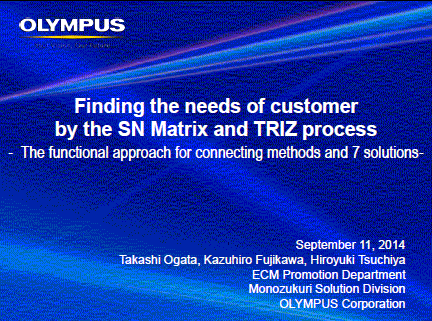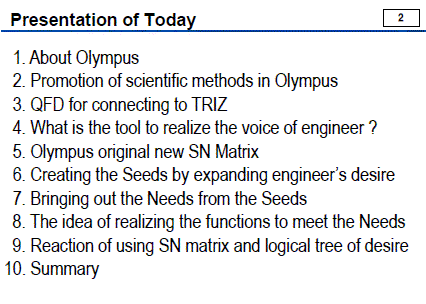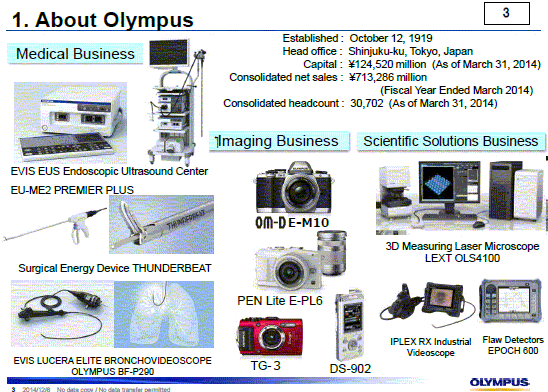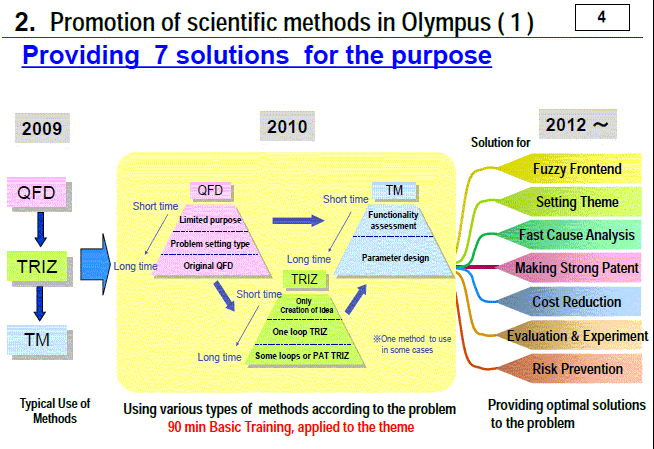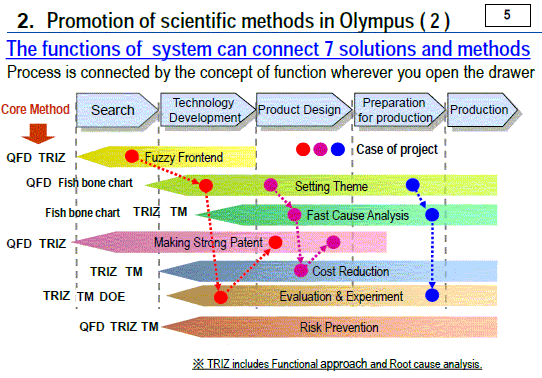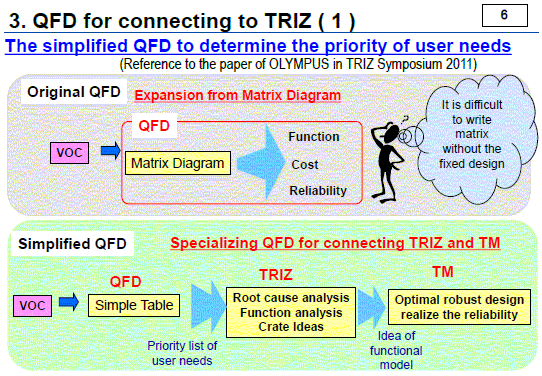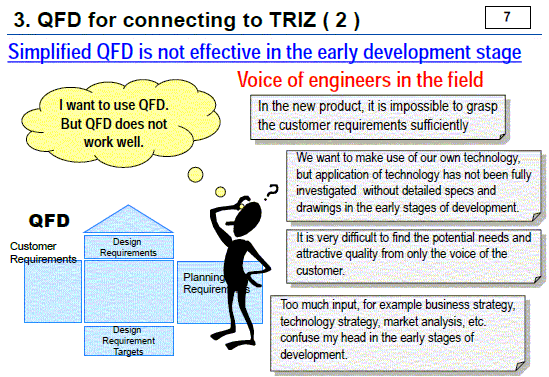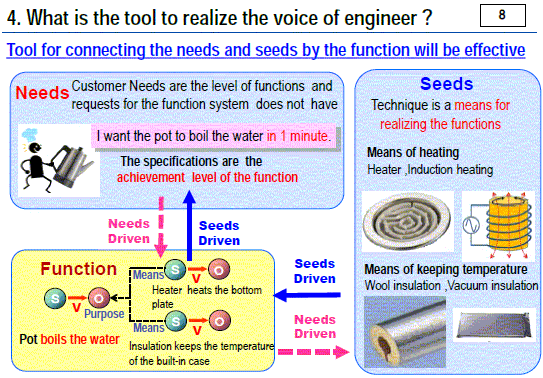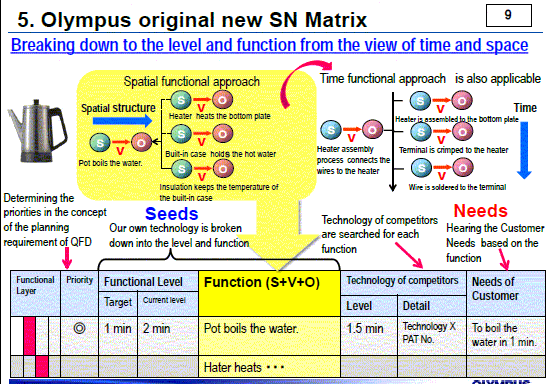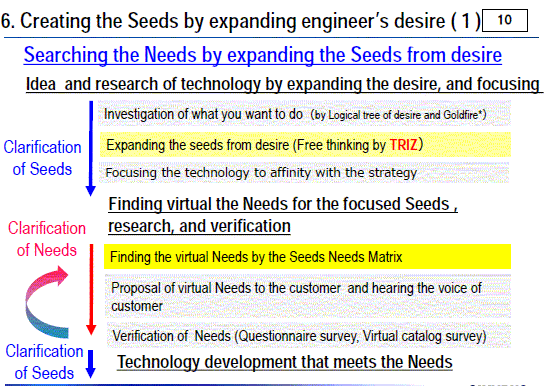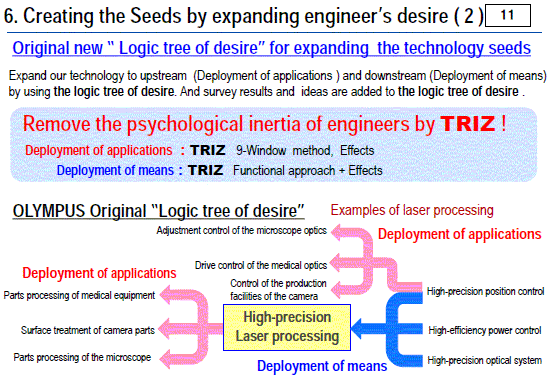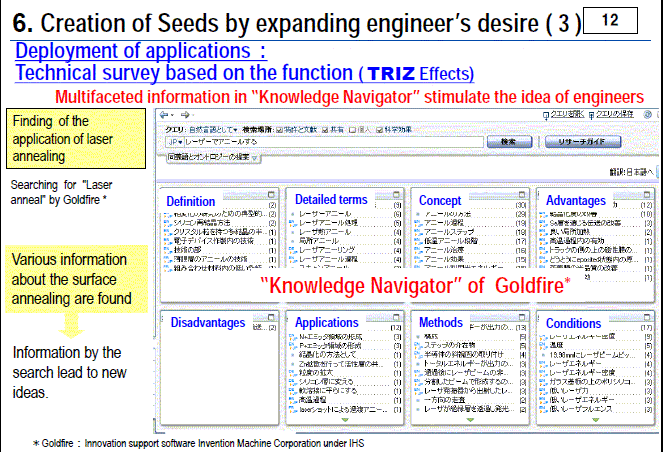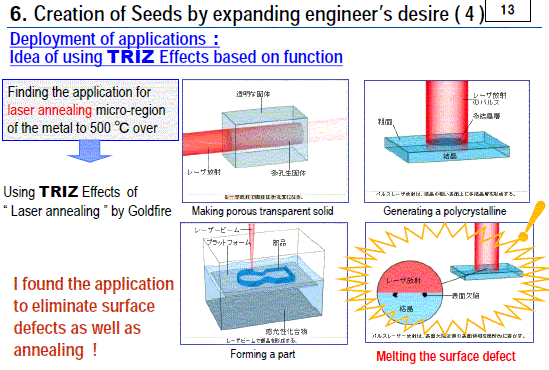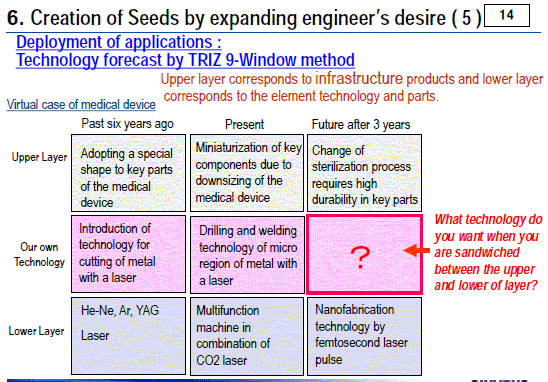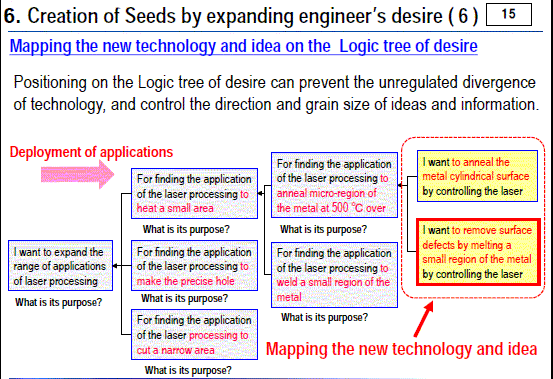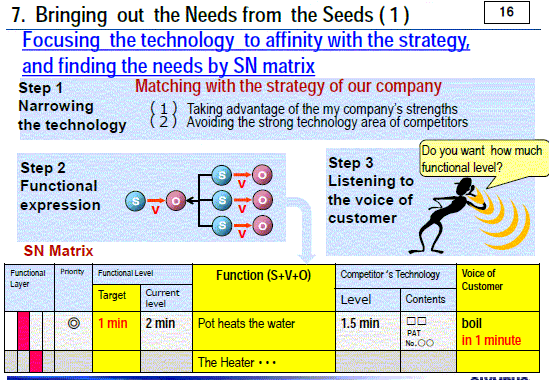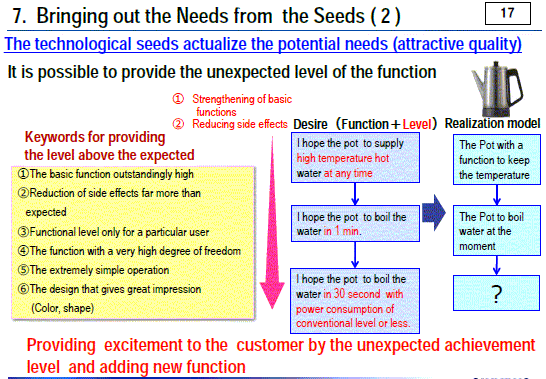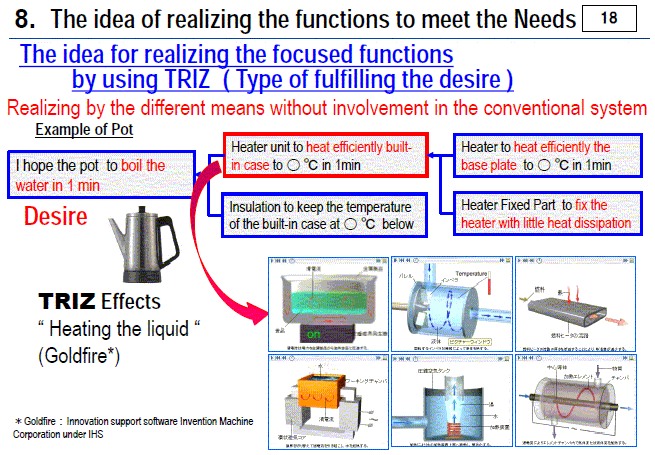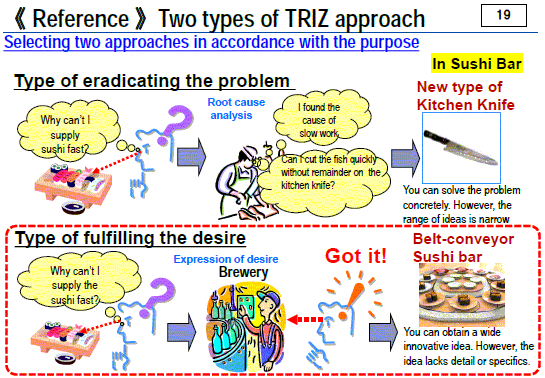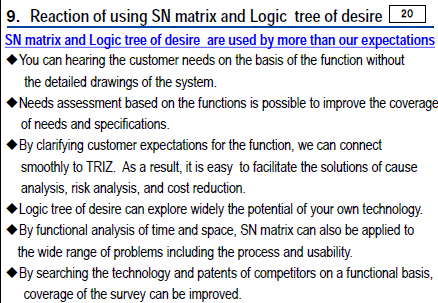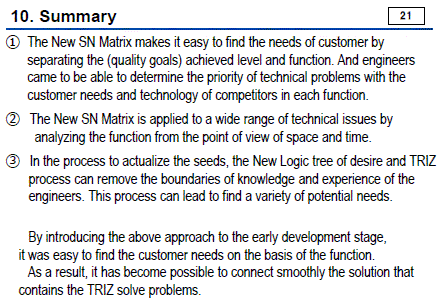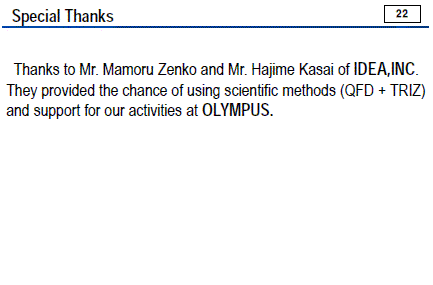This paper was presented last September at 10th Japan TRIZ Symposium and obtaind the 'Best presentation for me' Award as a result of participants voting. In my Personal Report of the Symposium  , I have introduce this paper as follows:
, I have introduce this paper as follows:
The authors pursue for the methods of linking their technological seeds (S) with their customers needs (N); they want to provide new products/services of attractive quality (by developing their technology) and to reveal some hidden needs of customers.
For such a purpose they have developed a scheme of describing their aims and means consistently in terms of 'functionality'; hierarchy of aims (for what aims/purposes they want to use their technologies) and of means (what types of means are available/needed for achieving the aims) are described.
For each of the function in the hierarchical scheme, the authors clarify their goal/current levels of realizing the function, competitors' technology (contents and their levels), customers' requirements, and priority, and write them down in a tabular form named as 'SN Matrix'.
With this representation method, they are well supported in the thinking processes of expanding their desires, finding the seeds along their strategies, drawing out the needs which requires the seeds, and generating ideas of realizing the functional means. In these thinking processes, they found TRIZ and its knowledge base tools (especially Goldfire) useful.
They also found that the representation scheme of functions in the SN Matrix is consistently applicable in their 7 categories of problem solving processes (or 'solutions').
-- This is an excellent presentation, having experiences of real applications and theoretical framework together.
It is remarkable indeed that the authors, Mr. Takashi Ogata and his group at Olympus Corporation, presented their papers for these 4 years consequtively at Japan TRIZ Symposia and won the 'Best Presentation for Me' Awards for allthe four years. Congratulations!! They say the TRIZ promotion activities are firmly supported by their top managements. The four papers are listed below (where  stands for a page in this site "TRIZ Home Page in Japan", while
stands for a page in this site "TRIZ Home Page in Japan", while  a PDF file publicly posted in the Official Web Site of Japan TRIZ Society).
a PDF file publicly posted in the Official Web Site of Japan TRIZ Society).
"Promotion of Scientific Methods Including TRIZ -- Challenge to the Output against Time in the Development Field --", Takashi Ogata and Naohisa Nakahara (Olympus Corp.), 7th Japan TRIZ Symposium, Sept.8-10, 2011 
"Promotion of scientific methods including TRIZ Part 2 -- Provide a variety of solutions in the field of development --", Takashi Ogata, Kazuhiro Fujikawa (Olympus Corp.), 8th Japan TRIZ Symposium, Sept. 6-8, 2012 
"7 Solutions to extend the application of TRIZ -- Including the prevention of design risk --", Takashi Ogata, Kazuhiro Fujikawa (Olympus Corp.), 9th Japan TRIZ Symposium, Sept. 5-6, 2013 
"Finding the needs of customer by the SN Matrix and TRIZ process -- The functional approach for connecting methods and 7 solutions --", Takashi Ogata, Kazuhiro Fujikawa, Hiroyuki Tsuchiya, 10th Japan TRIZ Symposium, Sept. 11-12, 2014  [The present page]
[The present page]
This page posts the follwings: Table of Contents of slides; Extended Abstract (of one A4 page, submitted to the Symposium in May 2014) in HTML and in PDF  ; Presentation slides in HTML images and a link to the PDF file
; Presentation slides in HTML images and a link to the PDF file  posted in the official Web site of Japan TRIZ Society. The Japanese page
posted in the official Web site of Japan TRIZ Society. The Japanese page  is composed in a simillar way.
is composed in a simillar way.
Table of Contents of the Slides
Title: Finding the needs of customer by the SN Matrix and TRIZ process -- The functional approach for connecting methods and 7 solutions --
Presentation of Today
1. About Olympus
2. Promotion of scientific methods in Olympus
(1) Providing 7 solutions for the purpose
(2) The functions of system can connect 7 solutions and methods
3. QFD for connecting to TRIZ
(1) The simplified QFD to determine the priority of user needs
(2) Simplified QFD is not effective in the early development stage
4. What is the tool to realize the voice of engineer ?
Tool for connecting the needs and seeds by the function will be effective
5. Olympus original new SN Matrix
Breaking down to the level and function from the view of time and space
6. Creating the Seeds by expanding engineer’s desire
(1) Searching the Needs by expanding the Seeds from desire
(2) Original new “ Logic tree of desire” for expanding the technology seeds
(3) Deployment of applications : Technical survey based on the function (TRIZ Effects)
(4) Deployment of applications : Idea of using TRIZ Effects based on function
(5) Deployment of applications : Technology forecast by TRIZ 9-Window method
(6) Mapping the new technology and idea on the Logic tree of desire
7. Bringing out the Needs from the Seeds
(1) Focusing the technology to affinity with the strategy, and finding the needs by SN matrix
(2) The technological seeds actualize the potential needs (attractive quality)
8. The idea of realizing the functions to meet the Needs
The idea for realizing the focused functions by using TRIZ (Type of fulfilling the desire )
《Reference》 Two types of TRIZ approach: Selecting two approaches in accordance with the purpose
9. Reaction of using SN matrix and Logic tree of desire
SN matrix and Logic tree of desire are used by more than our expectations
10. Summary
Special Thanks; Thank you for your attention
Finding the needs of customer by the SN Matrix and TRIZ process
- The functional approach for connecting methods and 7 solutions -
Takashi Ogata, Kazuhiro Fujikawa, Hiroyuki Tsuchiya (OLYMPUS Corporation)
Presented at 10th TRIZ Symposium in Japan, Sept. 11-12, 2014,
at Waseda University, Tokyo
Abstract
OLYMPUS has introduced and promoted QFD, TRIZ, and Taguchi Method as a scientific method for improving the development process since the 2009. Recently, we are promoting 7 Solutions to extend the application of TRIZ to meet the needs and targets of engineers. Focusing on the function of the system is important for connecting smoothly to the methods and solutions.
In this paper we introduce the new effective process in the elemental technology development stage and searching process. This process is re-organizing technology elements (Seeds) according to their function and finding the needs of customers in combination with the Seeds and Needs Matrix (SN Matrix) and TRIZ process.
In our company QFD →TRIZ → TM process was introduced as the ideal development pattern. Especially simplified QFD is useful and effective, for extracting technical problems from customer needs. (Reference to the paper of OLYMPUS in TRIZ Symposium 2011)
QFD is effective for clarifying the relationship of customer needs and product specifications in quality control purposes. However, QFD is not effective in the search stage and planning stage, because seeds and needs are not clear. Engineers want the process that can find the needs based on the seeds for connecting high affinity with TRIZ.
New SN Matrix with the concept of QFD and the function from the point of view of time and space is possible to connect easily TRIZ and other methods as follows.
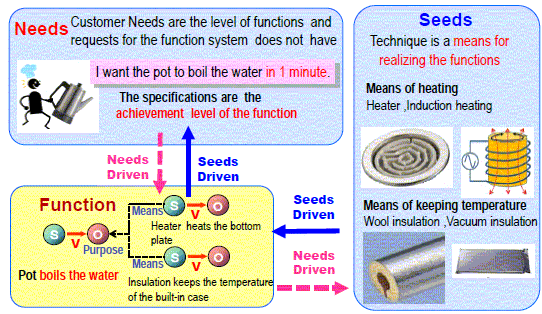
Fig. 1. Conecting the Seeds and Needs by Functions
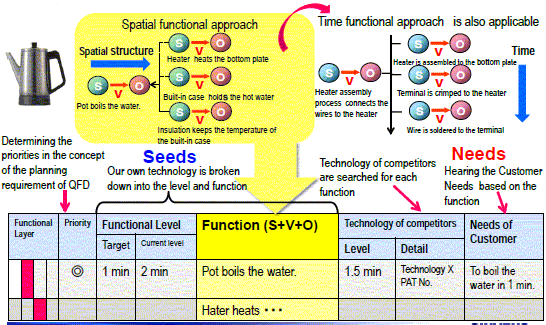
Fig. 2. An example of SN Matrix
1. The SN Matrix makes it easy to find the needs of customer by separating the (quality goals) achieved level and function. And engineers came to be able to determine the priority of technical problems with the customer needs and technology of competitors in each function.
2. The SN Matrix is applied to a wide range of technical issues by analyzing the function from the point of view of space and time.
3. In the process to actualize the seeds, the New Logic tree of desire and TRIZ process can remove the boundaries of knowledge and experience of the engineers. This process can lead to find a variety of potential needs.


